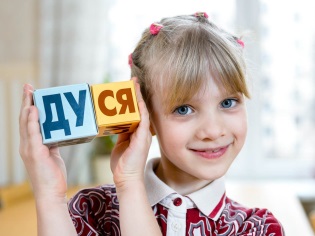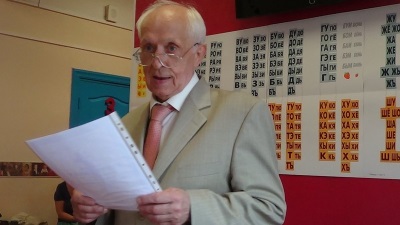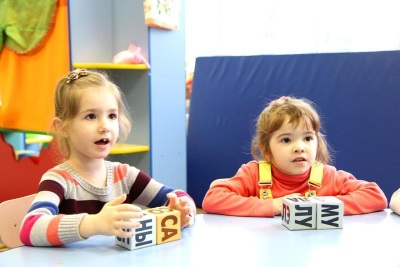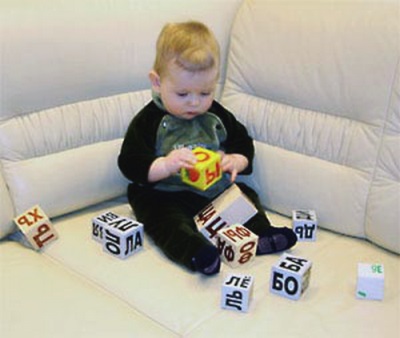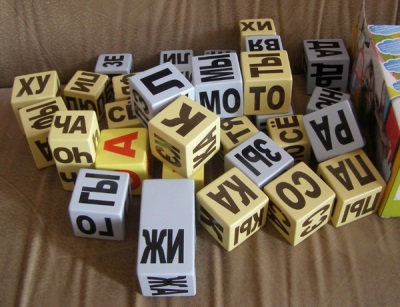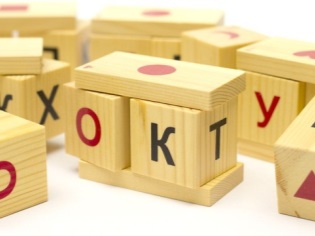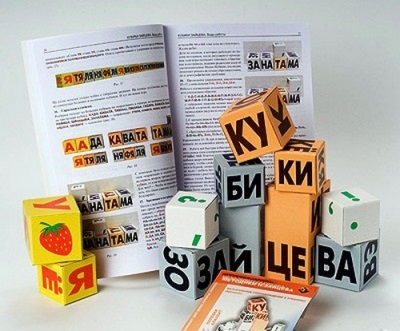Zaitsev's cubes - a popular method of teaching reading
All parents want their children to be the smartest, most developed. How much pride they feel when a 3-4-year-old kid, walking down the street, reads the names of shops and advertisements perfectly. ... And, starting teaching a child to read, they face a huge choice of various techniques. Zaitsev's cubes are an effective method of teaching children to read from a very young age. This is one of those techniques that is of great interest to many parents.
Who is Nikolai Zaitsev
Parents of Nikolai Alexandrovich Zaitsev worked in a rural school. After graduating from school, Nikolai worked for 2 years at the plant, after which he followed in the footsteps of his parents. In 1958 he entered the Pedagogical Institute at the Faculty of Philology. In the fifth year, he is sent to practice in Indonesia, where he works as a translator.
It was this period of time, when he had to teach adults not a native Russian language for them, that gave rise to the development of his famous method of teaching reading and writing. Implementing new techniques, creating interesting tables on the go, he tried to “convey the essence of the language to others.”
Having developed his own method of teaching, the young teacher decided to test it at the middle school classes of the secondary school. However, a huge setback awaited him here. Pupils could only learn the rules without trying to understand them. Accustomed to such training, they could not be reconstructed.
Then, Nikolai Aleksandrovich decided to try his method on kids. The technique was revised, all classes he conducted in a playful way. And here he was waiting for a huge success. Children, from the age of one and a half years, and preschool children, who had problems with reading and writing, needed only a few lessons in order to start reading. Some schools began to fully use his system of education, using the "ringing miracle" (as they called the cubes) in their work.
Watching the kids, the teacher came to the following conclusions:
- In order to learn to read, crumbs do not need to know how the letters are called. Most often in the alphabet letters are associated with pictures. The child remembers the image of the letter and the image that he associates with it. Then it is very difficult for him to explain that CAT (the letter K), SCISSORS (the letter H), TOY (the letter I), MUSHROOM (the letter D) and AIST (the letter A) add up to one word BOOK.
- Reading by syllables for a child is very difficult. Even if the kid learns the names of letters without pictures, it will be hard for him to understand how the syllable MA comes from the letters M and A. To understand the principle of merging syllables, teachers have to use various tricks in their work. But in Russian there are words from one syllable in which there are many consecutive consonants (for example, SPLASHK). Reading such words will be very difficult for a child reading in syllables.
- It is easier for a person to first learn to write than to read. By letter he understood the transformation of sounds into signs, and by reading - the transformation of signs into sounds. Baby, it will be much easier to learn to read through the letter.
In the next video you can learn interesting information about Nikolya Zaitsev and his legendary dice.
General principles of Zaitsev methodology
One of a kind author's method Zaitsev for over 20 years.However, the famous teacher does not stop constantly improving it. Many different methods and games have already been created that complement the base. With the help of the technique, it is possible to successfully teach even very young children with literacy. At the same time for preschoolers for 6 years only a few lessons will be enough, and you can see that he can already begin to read.
This method of training is suitable not only for children who like quiet games with cubes, but also moving restless children. The use of this technique is suitable for working with the hearing impaired, having very poor eyesight and deviations in the mental development of children. When working with them you can get very good results. You can see a good effect when working with children with autism.
In his methodology, Zaitsev emphasized that the processes of cognition in a child must go through all types of perception: auditory, visual, motor memory, touch and thinking. The teacher in the work with the kids should be able to organize a fun game learning environment, be in the role of a mentor in the learning process.
Using dice games:
- the dictionary of the kid will extend;
- literacy writing skills will be developed;
- child's speech will be more intelligible;
- You can fix a number of speech problems;
- develop the logic and thinking of the child;
- teach your baby to work independently.

Equipment
Standard set includes:
- 61 pcs. assembled cardboard cube
- 6 pieces cardboard tables with syllables, letters and other graphic signs
- 4 things. cardboard table format B3
- disk for listening with popevkami for cubes and tables
- methodical manual, which you can use as a summary of classes.
What is a warehouse
In his method, Nikolay Zaitsev offers an alternative to syllables - he uses warehouses. He is the main unit of the language. A warehouse can be a single letter, a combination of a vowel and a consonant, a consonant and a solid sign, a consonant and a solid sign. Such a principle of reading — storage — is the basis of the Zaitsev methodology. This technique is very similar with the primer Fedot Kuzmichev, XIX century, and the alphabet of L. Tolstoy. In these books, too, the principle of training in warehouses was used.
Warehouse can be determined by putting your hand below the chin and saying the word. The force of the muscles that you feel with your hand and will be a warehouse.
Warehouses for his method are located on the cubes and in the tables. He used sight, hearing and tactile sensations to help learning, since analytical thinking, the formation of which is required when reading, develops only by 7 years. Placing warehouses on cubes, Zaitsev made them different in color, sound, size. With this, when a child takes cubes, various channels of perception are activated.
Method Description
The creator of the methodology does not imply an authoritarian style of communication between a teacher and children. He says that we must take into account the individual characteristics and pace of development of each child.
Classes should take place only in a game form. Children should not sit in one place, they should move, jump, dance and sing. All movements in class are held in a game with cubes.
Cubes may vary in size. Large cubes depict warehouses with solid sound. On small cubes - with a soft sound. They can be single or double. On the double cubes are consonants, not combined with all vowels (Ms-Ms).
The sound of a warehouse is indicated by metal, and deafness by wood.
Gold - vowels. A solid sign is depicted on iron-wooden cubes, a soft one - on wooden-gold ones. On the white cube are punctuation marks. Color selection for letters is different from school. Here, blue is used to designate vowels, consonants are blue, and hard and soft signs are green.Such unlike school blue, red and green colors, according to Zaitsev, helps children begin to read fluently.
The filling of the cubes is also different.
Getting started learning to read first happens only with cubes, later they get acquainted with the tables.
Cubes 52 pcs. In the set, except for them there are 7 more. A total of 200 warehouses are depicted on the cubes.
Sets may be different:
- may be offered a layout for self-bonding cubes;
- may already have been collected;
- with a plastic base.
In order to glue the cubes yourself, it will take a lot of time. They need to be further strengthened from the inside. This can be done using a cardboard cube of the same size. After gluing, it is better to cover with rubber bands; this is necessary so that your cube does not fall apart while it dries. For better protection, coat each cube with film or laminate a cube scan. If you chose this option cubes, it is better to make a copy of each sweep. So in the course of the game, you will definitely have enough stores for writing words.
Tables should be hung rather high. This contributes to the prevention of scoliosis and visual impairment. If you are engaged only with your child, then it is better to determine the height by raising the hand of the baby. It should touch the top edge of the table. It will be convenient to hang the tables in the corners of the room, so it will be more convenient for the crumbs to look for the necessary warehouses. Tables can also be wrapped with film to increase the service life. Using tables is as important as playing cubes.
According to the method of Nikolai Alexandrovich, all the warehouses on the cubes should be sung. He believes that the effect of this is much better, and it is more interesting to work with music for the baby, which helps to instill an interest in learning.
Give the child to play all the cubes at once. This study guide should never be taken from him. They should always be in his field of vision. Let the baby get acquainted with them, carefully consider.
Ask to choose one of his most interesting cube. Warehouses written on its faces, you need to show singing. Ask to find a big cube, then a small, iron, wooden, gold. The child must understand that all cubes are different in size and sound.
After he has learned this information, introduce him to the syllable tables. Sing one of the columns of the table and ask the child to bring a cube with the same warehouses. Sing artistically, showing the child how warehouses can be: voiced or deaf, small or large. You can even use the appropriate movements. Do not ask your child to sing warehouses in return. When he is ripe for this, he will start singing with you and on his own.
Teach your child to write using dice or pointer. Singing warehouses and showing them on the table, the kid will begin to understand how words are composed. You can teach your child to write and play outdoor games at the same time. Ask him to write the names of loved ones in different parts of the room. And now let the child run to visit relatives.
Once again we pay attention, all occupations should take place only in a game form. The child should not sit in one place, give him complete freedom of movement. Every child is different. He does not have to do anything. Let the baby develop to the best of his abilities, do not rush things. Do not make a forced occupation out of the game. Of course, it is better to do every day, at least a little bit, but if a child today is not in the mood for classes, it is better to postpone him than to force him. You can play both in the morning and in the evening. Focus on the mood of the crumbs.
Choose the games that your child will enjoy the most. If you are fidget, it is better to use outdoor games in class. If your kid prefers quiet games collects puzzles for a long time, then use games that do not involve activity during the session.
If a pussy loves to build, then invite him to build locomotives with names, towers with warehouses, roads, houses out of cubes.
The author of the methodology assumes its successful use only on condition that all requirements are fully met, and not individual elements.
See the following video for the main points regarding children's education.
At what age can you start learning and which games to play?
It is possible to introduce the baby with cubes almost from birth. Consider that at this age the child is not yet capable of classes. Until six months the development of the child is a very fast pace. You should not overload it now. Cubes can be used as rattles, only occasionally showing him a warehouse or a word. Do not try to see any results during this period, do not expect them from the child. Now with their help, you only prepare the child for the training that awaits him ahead.
After 6 months, the child is no longer interested in playing with cubes, like with a rattle. Now you can start singing warehouses. Until the age of one, keep showing cubes, warehouses, simple words. Let the crumble crawl among them. You can try to ask him to give you a cube with a certain warehouse. Leave the warehouses on items that you have drawn up and during the day, show and sing them to your baby.
The older the child becomes, the more difficult the games are. One year old baby, along with those games that were before, you can already increase the level of difficulty by offering new ones. Act gradually. You can use the manual N. Zaitsev “Letter. Reading. Score ", which offered a lot of entertaining games, but you can invent your own. Connect the imagination of the baby, ask him what he wants to play games.
Play Zoo. Let the baby spread various animals around the zoo, making up their names from warehouses. In the "Shop", he can arrange the goods on the shelves. Going to the "Journey" should definitely collect a suitcase. Let him play the role of a cook, putting the ingredients necessary for cooking a soup or a favorite dish into a saucepan.
Offer your child to play the game “Who will call the most”. Call the words that start with a given warehouse. You can make this game themed.
Put cubes in front of him, from the warehouses on them should be possible to make his name. Let the kid try to do it yourself. Next time complicate the task, he must find suitable warehouses himself. Let him put words from cubes, and then look for these warehouses in the table, showing a pointer to the required warehouse.
In the games that you came up with together, the child will play with great pleasure, because they are much more entertaining for him than the ones offered by the author. These games will be exactly those that he likes, invented taking into account his interests.
Pros and cons of the technique
As with every modern technique, learning to read with the help of Zaitsev's cubes has its advantages and disadvantages. Consider more.
Virtues
- Children learn to read very quickly. It takes a little time for the child to start doing it. And the older he is, the faster the learning process. According to the author himself, even the guys who just turned 4 years old can start reading on their own after just 4 lessons. Of course, this does not apply to all children. On average, children of 3-4 years old need half a year to learn, an older preschooler needs 10-12 lessons, a 6-7 year old child will already have enough weeks.
- Zaitsev's teaching method is not tied to any particular age. You can start practicing when your child is 6 months old, or you can use it for first graders.
- Different in timbre, pitch and volume sounds made cubes, contribute to the development of hearing, memory, will develop a great sense of rhythm.
- As a result of games with cubes, fine motor skills of the child’s hands are actively developing, which is very important for the development of intelligence.
- Training takes place at a pace that allows the ability of the child. Everything is very individual. Nobody rushes and drives the guys, does not tell them that they owe something.
- Master the technique is not difficult. It can be successfully applied at home.
- Children immediately learn literate writing. On the cubes there are no warehouses that are impossible in the Russian language (such as FH, ZHY).
- The Zaitsev training method contributes to the prevention, preservation and promotion of health. While playing, the child trains the eye muscles. It helps to preserve vision. Its preservation contributes to the location of large text on the tables in different places, the bright color of the cubes, which does not irritate the eyes.
The gaming aids, which are located with due regard for the requirements of the methodology at the proper height and in different places, serve as an excellent prevention of violations of posture, physical inactivity, and workload with didactics.
In general, such a game method of teaching reading successfully helps in the development of a comprehensively developed harmonious personality.
- The method is based on the principles of pedagogy of cooperation, that avoids conflicts between children, parents and teachers.
- Children play themselves. It perfectly develops independence and self-organization. Even short classes for successful training are enough. Playing with them all the time, the invisibility of their conduct on the principle "by the way" will give an excellent result in training.
- The technique is very simple, systematized, visual.
- The child does not have to learn how to merge letters into syllables, he teaches ready-made warehouses, which promotes the ability to read fluently and without hesitation.
disadvantages
Despite the huge number of advantages when choosing this method of training, you can face a number of problems.
- Educators, pathologists and speech therapists say that by learning the warehouses, without understanding how to merge letters, children often begin to miss the endings of words. There may be problems when dividing words into syllables, parsing words by composition.
- Color sounds different from school (blue, blue, green instead of blue, green, red), create problems for the student in phonemic word analysis. Retraining children is more difficult than learning from scratch.
- The high cost of benefits. A lot of trouble when self-bonding cubes.
- There are certain difficulties in the choice of writing the letters E and E. On cubes there are warehouses such as BE, EE. In Russian, they can be found very rarely. We have to constantly stop the child’s desire to write the letter E in words, where, after a firm consonant, we hear E, and we need to write E (for example, the word TENNIS).
- The use of the technique will be more effective in children who are more developed right brain. They have a more developed figurative thinking.
- Guys may have difficulty isolating a single sound from a word, which will affect the letter.
- This way of learning is practically does not develop children's creativity.
Comparison with Chaplygin cubes
Evgeny Chaplygin created his method based on the Zaitsev method. However, his way of learning is unique and patented. Chaplygin's cubes set contains: 10 single cubes with letters and 10 double cubes forming blocks, instructions for use. Cubes in blocks rotate around their axis, forming warehouses.
Consider the main differences in methods.
- Chaplygin's cubes are easier to use.
- In the method of Chaplygin there is no memorization of warehouses, like in Zaitsev. He uses letters and syllables. It is easier for children to understand how to make up words.
- Chaplygin's cubes do not require much storage space.
- Zaitsev's cubes are made of paper or plastic, and Chaplygin's cubes are wooden.
- Buying Chaplygin cubes is much cheaper than Zaitsev cubes.
- Method Zaitsev contributes to the greatest development of children. Studying in it, the child gets acquainted with hard and soft consonants, voiced and deaf.
- Zaitsev in his method uses popevki and tables for better learning of the material by children.
- There are 52 warehouses on Zaitsev's cubes, and only 32 can be made of Chaplygin's cubes.
Parent reviews
Reviews about this method of teaching children to read are not straightforward.
There are parents who say that they saw a positive result almost immediately. Children enjoyed playing with cubes, made up words. Very early, the kids began to read fluently, reading books gives them great pleasure.
A number of parents did not immediately see the learning outcomes. Children have long been engaged to no avail. Only after a while the children began to read, and it was immediately good. The love of reading, which they embraced as a result of learning, they consider the most important achievement.
Some parents were able to see positive results only in a collective form of training with a specialist teacher. Studying at home did not bring individual results.
There are those whose children were able to master the technique only at the age of five and older. At an earlier age, the little ones did not understand the principles of warehouse reading.
There are adults who used only certain elements of the Zaitsev methodology to teach children to read. They talk about what they explain to their children how syllables should be drained, how warehouses are formed, and only then do words form warehouses on cubes and tables.
There are those children whose parents could not teach them to read using this method.
Also about learning to read Zaitsev's cubes, see the next video Smirnova T.N. - teacher preparation for school.
See the following video for an example of conducting training on this technique.
See the next video for answers to many questions on the technique of N. Zaitsev.


